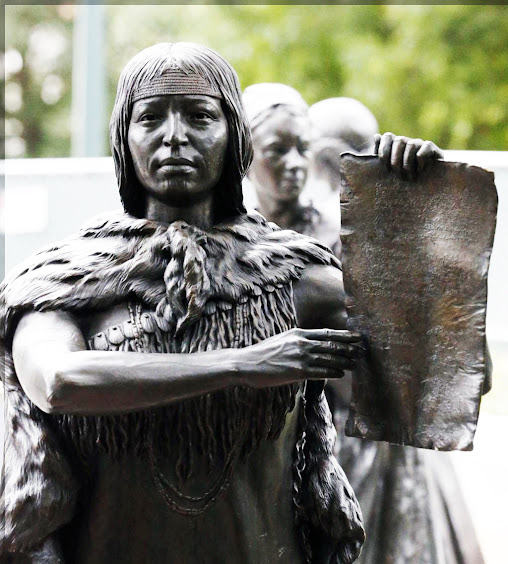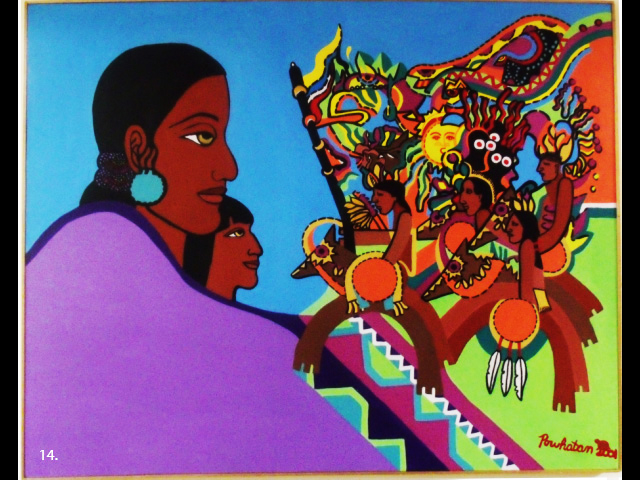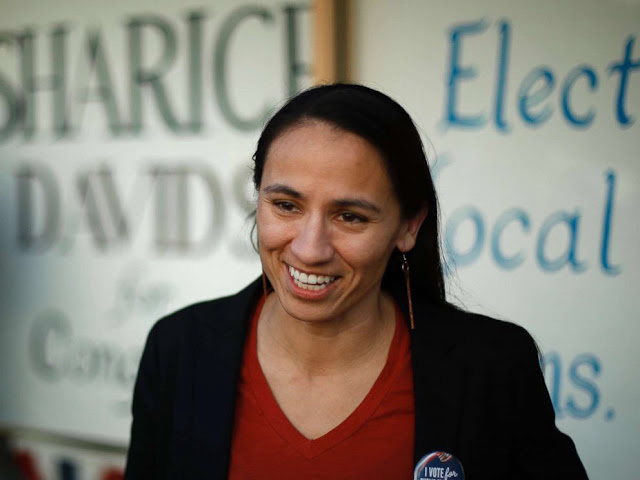The Horrendous Beginnings:
 |
“Invisible Indian” A graphic illustration that portrays the reality of the convenient invisibility of Native Americans from the National discourse, is based on guilt. |
The Encounter Period
The Role of Indigenous Women of the Americas
Indigenous women have always held a place of honor among their people. From Earth Mother to goddesses, tribal property owners, and matrilineal icons. Even our planet was seen as "Mother Earth.” Native women have occupied the highest rung in endemic societies. However, after the arrival of the first Spanish Europeans, the Indigenous woman became survivors of violence and dismissal. The Caribbean was the first to experience this chauvinistic horror.
 |
| Atabey, the Taino virgin goddess of childbirth and freshwaters. |
HONORING OUR INDIGENOUS AMERINDIAN WOMEN
In March, we honor the First Women of the Americas, some who paid the ultimate price for leadership or for just being the first to, unfortunately, encounter a hemispheric invasion.
The first recorded atrocity, a rape, occurred in 1493 on Columbus' return trip to the Caribbean. We know of her, but we do not know her name. She was a young Kalinago woman from Ay Ay, (meaning the "River" in Taino), a Leeward Caribbean Island which we now call St. Croix, (ironically meaning the "Holy Cross" in French). A similar concept to the Christ crucified on a cross, she was the first Indigenous victim of a Christian crime in her homeland. Michele da Cuneo flogged and raped an Amerindian woman.
Surprised at the arrival of the Spanish ships, while in a Kalinago canoe and fighting off a boatload of Spanish seamen from Columbus’ flagship, one of whom she shot an arrow through his shield with such force that it penetrated three inches into the attacker's chest, killing him. After a skirmish, she was captured by da Cuneo, an Italian lieutenant and a childhood friend of Columbus’ from his flagship, one of the 17 to 19 arriving vessels. The ensuing rope whipping and rape took place in da Cuneo's cabin on the Admiral's flagship. Ripping her attacker with her nails, her loud screams brought no help from Columbus or his crew.
 |
| "Rape of a Kalinago Girl: 1493", Sculpture by the author |
The first martyrdom of an Indigenous woman in our hemisphere to be recorded occurred in 1503 in Ayti Bohio, meaning "High Mountain Home," or Kiskeya, meaning "Mother of All Lands." Anacaona is our first named honoree who was the kacike or ruler of over 100 sub-kaciles in her province of Jaragua (Ha-rag-wah) located in today's Haiti on the second largest Caribbean Island. This island was the center of the Taino Civilization, whose vast Bagua, or the Caribbean Sea to the north, included hundreds of islands and cayaos (keys). In 1492, on the east shore of their northern island of Guanahni, or Island of the Iguana, land of the Lucayo or Lukku-Cari, i.e. "Small Island", they encountered men from Spain headed by the Italian wool merchant called Cristobal Colon by his Spanish employer, Queen Isabela. His real name was Cristoforo Colombo in his native Italian but was later Latinized as Christopher Columbus by English speakers.
 | |
|

 |
| Above composite sculpture by the author. |
CHESAPEAKE WOMEN IN 1585
The Powhatan Paramountcy 1607 to the Present
The Powhatan Paramountcy was the second Indigenous Encounter in North America in 1607. This is where the United States of America began. Founded as an eight Algonquian confederation by the first “Dreamer" or Powhatan I, his son, Wahunsenachaw was the second Powhatan who expanded the Algonquian political group into a 32-34 nation Paramountcy which the arriving English called a “Kingdom.” Their territory included affiliation with the Nanticoke or Kuskarawaoks people of Maryland and Delaware to the north. The ensuing conflicts between the Powhatans and the Virginia Company of England’s representatives and the English Crown ended in three Anglo-Powhatan Wars in Virginia, Maryland North Carolina, and Washington, DC. In suing for peace, Cockacoeske, the Queen of Pamunkey whose 1677 Treaty of Middle Plantation at Williamsburg, Virginia, ended the conflicts with the invading English and their ever-continuing violent expansion. This is the story of the great women of the Powhatan Paramountcy.
 | ||
Sculpture of Pamunkey Queen, Cockacoeske in the honored Women’s Monument at Capitol Square, Richmond, VA. She holds the 1677 Treaty of Middle Plantation as the major signatory on behalf of her people and the many Indigenous nations under her governance. The treaty ended the last of the three Anglo-Powhatan Wars of Homeland Security and set the stage for the American Revolution. |
 |
“Rainy Night Downtown”, is a painting of her DC city hometown by Georgia Mills Boston Jessup. Included in the Permanent Collection of the National Museum of Women in the Arts, Washington, DC. |
 |
“Urban Renewal”, is a collage painting by Georgia Mills Boston Jessup that comments on the removal of people of color in DC to make way for gentrification. |
Above: This is a video of a Land Acknowledgement given by Washingtonian Wisdom Keeper, Rose Powhatan a Pamunkey and Tauxenent descendant of the historic Powhatan Paramountcy in her yard in North West Washington, DC. Capitol Hill is known as the “Place of the Caucus” where Wahunsenachaw or Powhatan II, met in caucuses to promote solidarity with the surrounding Algonquian nations. Chroniclers during his lifetime said that “Powhatan never left his area.” The 32-34 nation Algonquian Paramountcy was governed by both women and men.
 |
“Storyteller” an acrylic painting by Rose Powhatan (Pamunkey/Tauxenent) is also an example of a mother passing on inspirational stories to her daughter. |
MYTH & REALITY
(1) Will the real Pocahontas please stand up!
 |
Rose Powhatan's “Pocahontas Unmasked” print by a Native American Pamunkey family member questions the portrayal of the iconic young woman’s physical interpretations. "Pocahontas was a full-blooded Native American young woman, not a European," the artist said. |
(2) The Island of Women
Indigenous women in the Americas were seen by the arriving Spanish as earthly members of the place of unequaled beauty which their awestruck men called the Terrestrial Paradise, technically identified as the biblical Garden of Eden. This impression was concretized when Columbus first arrived on Guanahani (renamed San Salvador) in October of 1492. By sign language, he was introduced to the Taino epic of Matanino, the Island of Women, and Guanin, its twin Island of Gold. Father Pané later recorded this epic in more detail on Hispaniola.
 |
An illustration of Queen Califia of the Island of "Black" Amazons called La California protected from men by griffins, and whose only weapons were made of gold. This story was adapted as Las Sergas de Esplandián (The Adventures of Esplandián) a popular novel written by Garci Rodríguez de Montalvo. It was probably adopted by the Spanish 16th-century novelist from Fray Ramón Pané’s recorded manuscript on the Caribbean Island of Hispaniola (Kiskeya/Ayti Bohio) titled "Account of the antiquities of the Indians." In about 1498 after the Tainos began attacking the Spanish invaders, Pané compiled and presented to Columbus his Relación acerca de las antigüedades de los indios ("Report about the antiquities of the Indians"). This account was known to have contained accurate and unbiased descriptions of the Taino beliefs and was used by Peter Martyr, las Casas, and Ferdinand Columbus. |
WOMEN OF POWER
 |
Frida Khalo was a Mexican painter, proud of her Indigenous ancestry and dressed in their style, whose feminism is still admired by many. She is celebrated in Mexico for her attention to Mexican and indigenous culture and by feminists abroad for her depiction of the female experience and form. "I paint self-portraits because I am so often alone because I am the person I know best." |
 |
Representative Sharice Lynnette Davids (Ho-Chunk Nation of Wisconsin) was born May 22, 1980, was raised by a single mother, who served in the Army for 20 years. After graduating from Leavenworth High School, she worked her way through Johnson County Community College and the University of Missouri-Kansas City before earning a law degree from Cornell Law School. As a first-generation college student who worked the entire time she was in college, Rep. Davids understands the importance of quality public schools and affordable higher education. It is that foundation that allowed her to go on to a successful career, focused on economic and community development, which included time as a White House Fellow under President Barack Obama. When she was sworn into the 116th Congress, Rep. Davids became one of the first two Native American women to serve in Congress. |
 |
An Hour-long Congressional Condemnation of hatred by some men against women: https://youtu.be/jUIbIWgBWo8 In January of 2019, Congresswoman Ocasio-Cortez who is descended from the Taino People of Puerto Rico (Borinquen) was sworn in as the youngest woman and youngest Latina ever to serve in Congress. Her first piece of legislation was the Green New Deal resolution, which envisions a 10-year national mobilization, akin to FDR’s New Deal, that would put millions to work in good-paying, union jobs repairing the nation’s infrastructure, reducing air and water pollution, and fighting the intertwined economic, social, racial and climate crises crippling the country. Over her first term, she introduced a total of 23 pieces of legislation. Among them is her Loan Shark Prevention Act, which would cap credit card interest rates at 15%. The Congresswoman also introduced a group of bills collectively titled ‘Just Society,’ which would raise the federal poverty line, include immigrants in social safety net programs, require federal contractors to pay a living wage, strengthen renters' rights, and decrease recidivism. “There are some politicians who are very good on policy, and there are some politicians who are good communicators, and there are some politicians that have a way about them that relates very well to ordinary people. Alexandria has all three of those characteristics.” – Senator Bernie Sanders |
Wilma Mankiller, in full Wilma Pearl Mankiller, (born November 18, 1945, Tahlequah, Oklahoma, U.S.—died April 6, 2010, Adair County, Oklahoma), Native American leader and activist, the first woman chief of a major tribe.
Mankiller was of Cherokee, Dutch, and Irish descent; the name Mankiller derives from the high military rank achieved by a Cherokee ancestor. https://www.womenshistory.org/education-resources/biographies/wilma-mankiller
“One of the things my parents taught me, and I'll always be grateful . . . is to not ever let anybody else define me; [but] for me to define myself. ”
NOTES:





















